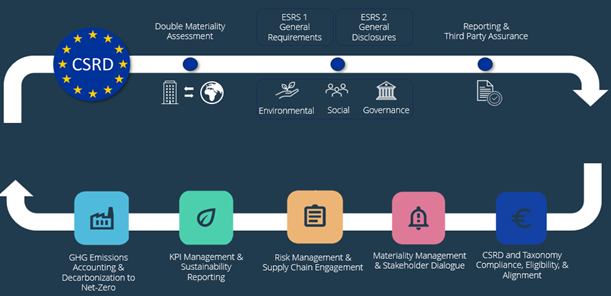How can CEMAsys help customers with CSRD?
The Corporate Sustainability Reporting Directive (CSRD) is a comprehensive framework with multiple reporting requirements, setting high demands for a company’s sustainability reporting. Having a robust system solution in place is crucial to ensure a structured and compliant reporting process. CEMAsys has developed a CSRD package to make it easier for companies to report according to the standards and for auditors to review.
The first step of CSRD is to conduct a double materiality assessment. The objective is to review the integral components of the CSRD, connected to the different European Sustainability Reporting Standards (ESRS), and determine whether these components are material or not. Once the company has decided which components of the ESRS to report on, these should be validated by an auditor to ensure that they are eligible.
The next step will be to gather the data connected to the components deemed material by the company. Data should be collected according to the mandatory reporting areas, and once collected, be reviewed again by an auditor.
By using our tailored system solutions and in-house expertise, you will be able to comply with all the steps of the extensive sustainability reporting structure of the CSRD.

Here is how CEMAsys can help you as our customer:
CSRD GAP Tool and Double Materiality workbook
We have designed a GAP Tool for customers to get an overview of the disclosure requirements in the CSRD and identify their gaps. The customer will receive a gap score insinuating their status of compliance, and the results are visualized in an intuitive dashboard for the company to clearly spot their gaps and start steering their road towards compliance.
Our Double Materiality workbook is constructed to assist you when defining what components in the CSRD are deemed material to your company. The workbook can be used throughout the processes as a steering tool helping you structure all the information required.
Carbon Footprint module

This module helps companies gather emissions data connected to all the criteria defined in the CSRD. Using tailormade templates, companies can easily insert their emissions data and calculate their emissions in accordance with the GHG protocol.
When having access to this module, you will also have access to our Low Carbon Transition tool. This tool is designed to help companies plan their transition towards a low carbon transition. Having a climate transition plan is one of the requirements set out by the CSRD. Hence, this tool will help companies start planning their transition journey and meet the demands of CSRD.
ESG Metrics Module

ESG Metrics support companies with gathering both qualitative- and quantiative data required in the CSRD. Reporting is made easy using our templates aligning with the elements of the double materiality assessment process. Data connected to biodiversity, water, pollution, governance, circular economy and other ESG-related factors can be reported in this module, enabling alignment with the topical standards of the ESRS concerning Environment, Social and Governance.
Supply Chain Control module

The Supply Chain Control module gives you access to the GAP Tool for mapping out the 10 ESRSs and identifying your gaps. Additionally, this module makes it easy to engage your stakeholders, which is a crucial part of the CSRD process. Our Supply Chain Control module provides you with premade survey templates for you to easily send out to your whole supply chain. Use the dashboard function in the module to monitor the results from your surveys and get a full overview of the overall performance.
Activity Logs module

Having a continuous stakeholder dialogue is a key aspect of the double materiality assessment. By using our Activity Logs module, you can easily communicate with your stakeholders throughout the year and follow up on your stakeholder dialgoues during the process. When having access to this module, you can easily send out notifications to your employees and suppliers for them to fill out reports our register aviations in real time. All registered data can be analyzed and used by the company to improve their sustainability practices.
EU Taxonomy module

The CSRD requires companies to report their sustainability performance against the requirements of the EU Taxonomy. The EU Taxonomy module allows you to screen your business activities and assess their eligibility and alignment against the activities defined in the taxonomy.
CSRD Module
CEMAsys is currently developing a new module specifically designed for the purpose of complying with the CSRD. In the meantime, you will be able to report the required information using our existing modules. When the CSRD module is up and running your already reported data will be aggregated to this module, and all the dots will be connected for you to finalize your CSRD report. Our ESG-expert consultants can help facilitate your whole CSRD process, and navigate your company towards sustainability success.
Kategorier
- About Cemasys (8)
- Carbon Accounting (8)
- CDP (4)
- Climate Risks (6)
- Climate Strategy (8)
- CSRD (5)
- Due Diligence (5)
- ESG Reporting (4)
- EU Framework (1)
- EU Taxonomy (2)
- GHG Protocol (1)
- GRI (2)
- Insights (11)
- Materiality Assessment (1)
- Net-Zero (2)
- NFRD (1)
- Recent webinars & videos (17)
- SBT (3)
- Scope 3 (2)
- TCFD (2)
- Ukategorisert (60)

